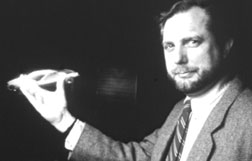Dedication
Introduction
Dan Ariely
Walter Bender
Steve Benton
Bruce Blumberg
V. Michael Bove, Jr.
Cynthia Breazeal
Ike Chuang
Chris Csikszentmihályi
Glorianna Davenport
Judith Donath
Neil Gershenfeld
Hiroshi Ishii
Joe Jacobson
Andy Lippman
Tod Machover
John Maeda
Scott Manalis
Marvin Minsky
William J. Mitchell
Seymour Papert
Joe Paradiso
Sandy Pentland
Rosalind Picard
Mitchel Resnick
Deb Roy
Chris Schmandt
Ted Selker
Barry Vercoe
Steve Benton
At the risk of overusing the word "passion"—which seems destined for the same unhappy fate as "creativity"—I have a passion for helping cocksure ignorance evolve into thoughtful uncertainty, for tickling my 3-D funnybone, and for being in the room when exciting new things are being created.
 Holography has two meanings in our world: the specific Nobel prize-winning interference-and-diffraction discovery by Dennis Gabor, and the more general "psychologically ultimate 3-D imaging of the future," as envisioned in movies and TV. Our job is to move the second holography toward reality without violating more than one law of physics at a time. Which is to say that while we can't quite produce "Princess Leia" (which requires turning photons around in mid-air), we have done some other interesting things that were considered practically impossible just a few years ago—for example, the creation, transmission, and display of electronic 3-D holograms. This required that we understand the needs of human spatial vision, build a new kind of electronic frame buffer, and invent a new optical display system. All three had to happen in close synchronization, something that was possible only at the Media Lab, with its unique mix of multi-disciplinary assets.
Holography has two meanings in our world: the specific Nobel prize-winning interference-and-diffraction discovery by Dennis Gabor, and the more general "psychologically ultimate 3-D imaging of the future," as envisioned in movies and TV. Our job is to move the second holography toward reality without violating more than one law of physics at a time. Which is to say that while we can't quite produce "Princess Leia" (which requires turning photons around in mid-air), we have done some other interesting things that were considered practically impossible just a few years ago—for example, the creation, transmission, and display of electronic 3-D holograms. This required that we understand the needs of human spatial vision, build a new kind of electronic frame buffer, and invent a new optical display system. All three had to happen in close synchronization, something that was possible only at the Media Lab, with its unique mix of multi-disciplinary assets.
Beyond that, we have superimposed the holographic display with a "touch and feel" haptic display, and developed software so that the image can literally be touched and probed, and even carved by pressing harder. Interactivity is a primary motivation for most of our digital technology, and this "haptic holo-video" system breaks entirely new ground in interface design and expectations.
But our world is an impatient world too, and so we are also working on holographically inspired 3-D systems that require no special glasses to see, and that might become practical within the next few years. They are based on camera technologies that divine exactly where the viewer's right and left eyes are in space, and agile optical systems that deliver the right and left eye views to exactly those two locations. As the viewer moves from side to side, new perspective views are very rapidly computed and presented, so that the image's appearance approaches that of a hologram, with "look around" and "look over and under" elements.
Will our inventions ever present a truly satisfying "window view upon reality," whether from a digital source or a remote location? Well, it is still the early days, comparable to the 1920s for television, which is why we consider spatial imaging to be a worthy academic research topic. But our world's appetite for the realism and engagement that truly high quality 3-D can offer won't be satisfied until we finish the job. The challenges are many, and the solutions are not simple, inexpensive, or just around the corner. Some fundamental inventions are still waiting to be made! We are tracking them down using intuition, science, and experience, plus all the new tools that MIT can offer.
Favorite childhood toy: definitely the old mechanical construction sets!